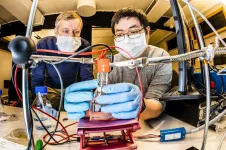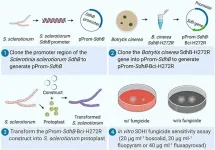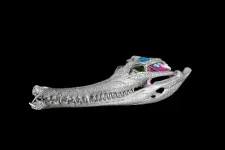(Press-News.org) Pediatric melanoma is a rare disease with only around 400 cases diagnosed in the United States every year. To better understand this disease and how best to treat it, St. Jude Children's Research Hospital scientists created a registry called Molecular Analysis of Childhood MELanocytic Tumors (MACMEL). A paper on findings from the registry was published today in Cancer.
"What is different about the MACMEL registry is that it is prospective," said corresponding author Alberto Pappo, M.D., St. Jude Solid Tumor Division director. "We're seeing the vast majority of enrolled patients as part of the melanoma clinic at St. Jude. We can follow these patients and conduct detailed pathology and molecular analysis."
More than one disease
Through such efforts as the St. Jude-Washington University Pediatric Cancer Genome Project, scientists learned that pediatric melanoma is really not one disease, but multiple diseases. These subgroups include:
Conventional melanoma: melanocytic lesions with features similar to adult melanoma that occur almost exclusively in adolescents. These tumors often have BRAF and TERT promoter mutations.
Spitz melanoma and atypical Spitz tumors: occur in younger patients and are characterized by copy number alterations. These tumors typically have kinase fusions involving MAP3K8, NTRK, ALK, ROS1, RET, BRAF or MET.
Giant congenital nevus melanomas: aggressive tumors that have NRAS mutations and upregulation of TERT.
No reliable clinical or morphologic features can accurately predict the clinical behavior of melanoma tumors in children. However, the registry provides the opportunity to better understand the natural history of these tumors and, potentially, treat them.
Registry findings
"What we're seeing from the registry's data is that these are incredibly diverse tumors. Some patients need drastic measures. For many others, masterful watching is the best option," said last author Armita Bahrami, M.D., formerly of St. Jude and now of Emory University. "It is critical for the care team to consider all available clinical, pathologic and genomic data in order to assign patients to the appropriate risk category."
The registry has been open and enrolling patients since 2016. The researchers analyzed data from the first 70 patients enrolled and categorized them as either one of the three recognized subgroups, or as "other." From the registry, the researchers were able to determine that most spitzoid melanomas have a gene fusion, most commonly involving MAP3K8. They also found that spitzoid melanomas that do not have a TERT mutation have a benign clinical course.
For conventional melanoma, the researchers found that the most common mutation was in the gene BRAF. Conventional melanoma patients with advanced disease did not do as well as those diagnosed with early stage disease. The study also showed that giant congential nevus melanomas all had NRAS mutations and all patients died of their disease.
A focus on rare disease
These results highlight the need to take into consideration the patient's age, pathology review and integrated genomic analysis not only to arrive at the right diagnosis but to anticipate the clinical behavior of these tumors.
"Now that we have all of this information available, we can be significantly more selective and integrate this information into treatment decision making," Pappo said. "It will help us provide the best information possible for the patient as far as prognosis, recurrence and the need for additional surgery or therapy."
A majority of the patients included in the registry were treated at St. Jude through a dedicated clinic for pediatric melanoma. The clinic is ongoing and has been held virtually during the COVID-19 pandemic.
INFORMATION:
The study's other authors are Teresa Wright, University of Tennessee Health Science Center, and Valerie McPherson, Haitao Pan, Fang Wang, Lu Wang, Margaret Hussong, Dana Hawkins, Sue Kaste and Andrew Davidoff, all of St. Jude.
The study was funded by the National Institutes of Health (P30CA021765) and ALSAC, the fundraising and awareness organization of St. Jude.
St. Jude Children's Research Hospital
St. Jude Children's Research Hospital is leading the way the world understands, treats and cures childhood cancer and other life-threatening diseases. It is the only National Cancer Institute-designated Comprehensive Cancer Center devoted solely to children. Treatments developed at St. Jude have helped push the overall childhood cancer survival rate from 20% to 80% since the hospital opened more than 50 years ago. St. Jude freely shares the breakthroughs it makes, and every child saved at St. Jude means doctors and scientists worldwide can use that knowledge to save thousands more children. Families never receive a bill from St. Jude for treatment, travel, housing and food -- because all a family should worry about is helping their child live. To learn more, visit stjude.org or follow St. Jude on social media at @stjuderesearch.
University of California San Diego School of Medicine researchers have identified a possible link between inadequate exposure to ultraviolet-B (UVB) light from the sun and an increased risk of colorectal cancer, especially as people age.
Reporting in the journal BMC Public Health, researchers investigated global associations between levels of UVB light -- one of several types of ultraviolet light that reach the Earth's surface -- in 2017 and rates of colorectal cancer across several age groups in 186 countries in 2018.
Lower UVB exposure was significantly correlated with higher rates of colorectal ...
Manufacturing - Powered by nature
A team of researchers at Oak Ridge National Laboratory demonstrated the ability to additively manufacture power poles from bioderived and recycled materials, which could more quickly restore electricity after natural disasters.
Using the Big Area Additive Manufacturing system, the team 3D printed a 55-foot pole designed as a closed cylindrical structure. They evaluated three different composite materials with glass fibers including cellulose ester, recycled polycarbonate and bamboo fiber reinforced polystyrene.
"We developed a modular design that is easy to manufacture, transport and assemble," ORNL's Halil Tekinalp said. "Sections within the pole can ...
BOSTON - A skin pigmentation mechanism that can darken the color of human skin as a natural defense against ultraviolet (UV)-associated cancers has been discovered by scientists at Massachusetts General Hospital (MGH). Mediating the biological process is an enzyme, NNT, which plays a key role in the production of melanin (a pigment that protects the skin from harmful UV rays) and whose inhibition through a topical drug or ointment could potentially reduce the risk of skin cancers. The study was published online in Cell.
"Skin pigmentation and its regulation are critically important because pigments confer major protection against UV-related cancers ...
A transplant of healthy gut microbes followed by fibre supplements benefits patients with severe obesity and metabolic syndrome, according to University of Alberta clinical trial findings published today in Nature Medicine.
Patients who were given a single-dose oral fecal microbial transplant followed by a daily fibre supplement were found to have better insulin sensitivity and higher levels of beneficial microbes in their gut at the end of the six-week trial. Improved insulin sensitivity allows the body to use glucose more effectively, reducing blood sugar.
"They were much more metabolically healthy," said principal investigator Karen Madsen, professor of medicine in the Faculty of Medicine ...
Researchers at Linköping University have developed a method that may lead to new types of displays based on structural colours. The discovery opens the way to cheap and energy-efficient colour displays and electronic labels. The study has been published in the scientific journal Advanced Materials.
We usually think of colours as created by pigments, which absorb light at certain wavelengths such that we perceive colour from other wavelengths that are scattered and reach our eyes. That's why leaves, for example, are green and tomatoes red. But colours can be created ...
Succinate dehydrogenase inhibitors (SDHIs) are a class of fungicides widely used to control many fungal diseases of crops. The relationship between SDHIs and fungi can be compared to finding the right key for the right lock. However, fungi are adaptable and develop resistance to fungicides often by changing the lock so that the SDHI is no longer able to open the door. Because of this adaptability, it is important to understand the biological mechanisms of fungicide resistance.
A recent collaboration between scientists in Michigan and Massachusetts as ...
However, the majority of these organisms are believed to be in a state a state of 'dormancy' due to environmental stress, such as nutrient-poor conditions. An international team of scientists led by Dagmar Woebken and Stephanie A. Eichorst from the University of Vienna investigated how acidobacteria, which are widespread in soils, can survive under adverse conditions. Two recent studies published in The ISME Journal and mSystems describe these survival strategies.
The living conditions that microorganisms encounter in soils are unpredictable and challenging. Nutrients and oxygen are frequently scarce for long periods. Acidobacteria manage to defy these extreme conditions. They are found in an astonishing diversity in soils worldwide. "Since they are this widespread, ...
The death of cells is well regulated. If it occurs too much, it can cause degenerative diseases. Too little, and cells can become tumours. Mitochondria, the power plants of cells, play a role in this programmed cell death. Scientists from the University of Groningen (the Netherlands) and the University of Pittsburgh (U.S.) have obtained new insights in how mitochondria receive the signal to self-destruct. Their results were published in the Journal of Molecular Biology.
How does a cell kill itself? The details of this process are still unclear. Patrick van der Wel, associate professor ...
PLYMOUTH MEETING, PA [July 6, 2021] -- New research in the June 2021 issue of JNCCN--Journal of the National Comprehensive Cancer Network assesses the quality of cancer care delivered through extended sites coordinated by some of the country's largest cancer centers. The study was developed to implement strategies for disseminating discoveries and expanding access to the highest quality cancer care as part of AACI's Network Care Initiative, established by former AACI President Stanton L. Gerson, MD, Director of the Case Comprehensive Cancer Center. Results were calculated based on responses to a mixed-methods survey answered by 69 cancer centers between September 2017 and December 2018, at which time 56 reported at ...
The braincase of crocodylians has a distinctive structure. Unlike evolutionary relatives (birds and squamates), in crocodylians, all braincase bones are rigidly fixed together and form an akinetic structure. In the process of evolution, this made it possible for animals to develop powerful jaws and stronger bite forces, thanks to which crocodylians could gnaw through the hard shell of crayfish and turtles and hunt fish and land animals, including dinosaurs. As a result, they have managed to fill the niche of predators and survive to the present day.
At present, in comparison with other parts of the crocodylian skull, the structure of their braincase has been understudied. This is because, until recently, scientists did not have ...






